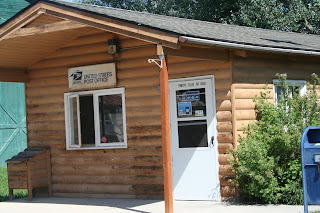It so happens that the first government financed irrigation project, Huntley Project was a few miles up the road from Pompey's Pillar. Huntley Project allowed farmers to begin to make a go of it in the Pompey's Pillar/Huntley area. Before the irrigation project, many settlers tried to farm, but most of them went bust. We visited the Huntley museum and talked with the curator, Melissa Koch. She gave a us a platt and showed us where the homestead was located on the platt. She also gave us information about the original town and how homesteading worked for the settlers.
In 1913 O.D. Robertson and Maude Brodock Robertson homesteaded Farm Unit I, sections 22 and 27, almost adjacent to the Pompey's Pillar monument itself and fairly close to the river, although not bordering on it. Fly Creek and the railroad ran through their farm.
 |
| Captain Clark's signature |
Years ago, I found pictures O.D. Robertson had of the Huntley project when it was being built. The back of the pictures state, "Working on Huntley Canal Project OD Robertson." Some say "Huntley Canal Project Contract, O.D. Robertson." These leads me to surmise that my grandpa, who hired out himself and his horses worked on that project.
 |
| Back of this picture says, " Working on Huntley Canal Project Contract O.D. Robertson" This is one of three pictures of Huntley Project that O.D. Robertson had. |
O.D. and Maude had a dairy farm that seems to have been successful if O.D.'s tally book tracking the amount of milk his cows produced daily is anything to go by. Every morning he would load his milk onto the train bound for Billings.
 |
| The most impressive building in Pompey's Pillar |
 |
| The most impressive girl in Pompey's Pillar |
 |
| Pompeys Pillar - looks like an old livery stable |
 |
| Pompey's Pillar Post Office |
Sadly, after losing their son, Teddy to a mysterious and lingering illness and almost losing their daughter, Winifred, and younger son, Sid, O.D. and Maude sold the farm. They thought the water was bad and making their children sick. Melissa Koch confirmed that the water in the area is not the best.
For their son, Teddy's funeral, Maude and O.D. rode the train from Pompey's Pillar to Great Falls, where Robert Theodore Robertson is buried in the old part of the cemetery behind the mall. Great Falls was close to both O.D.'s father's ranch and Maude's family's ranch. Both ranches were near Millegan, Montana.
Some things don't change. The need to be with our family during a time of heartbreak is one of those things.
Teddy's death was published in the Billings' and Great Falls' newspapers. I found the clippings when I looked through old letters. I also discovered a letter from a minister offering his services to conduct the funeral. Maude and O.D. took him up on the offer. At this time, neither Maude or O.D. had any religious leanings. I can't imagine enduring the death of my baby without my religion to comfort me and help me with my perspective. This must have been an awful time for both Maude and O.D.
While genealogy can be lots of paperwork with names, dates, and places, it can also involved some fascinating information brought to light by detective work. After we've lived a few years and experienced a few things, we know the aching hearts and turmoil attached to hard experiences. The names, dates, and personal experiences work together to lead us to empathize with those who went before us.


3 comments:
How cool! It sounds like the museum curator has a cool job! I want to see the spot sometime.
What a great visit we had! I felt so close to Grandpa and his family. It was so neat to share what we knew with the museum curator, too.
What a fun trip! I've never been there, but it looks like I'll have to go sometime!
Post a Comment